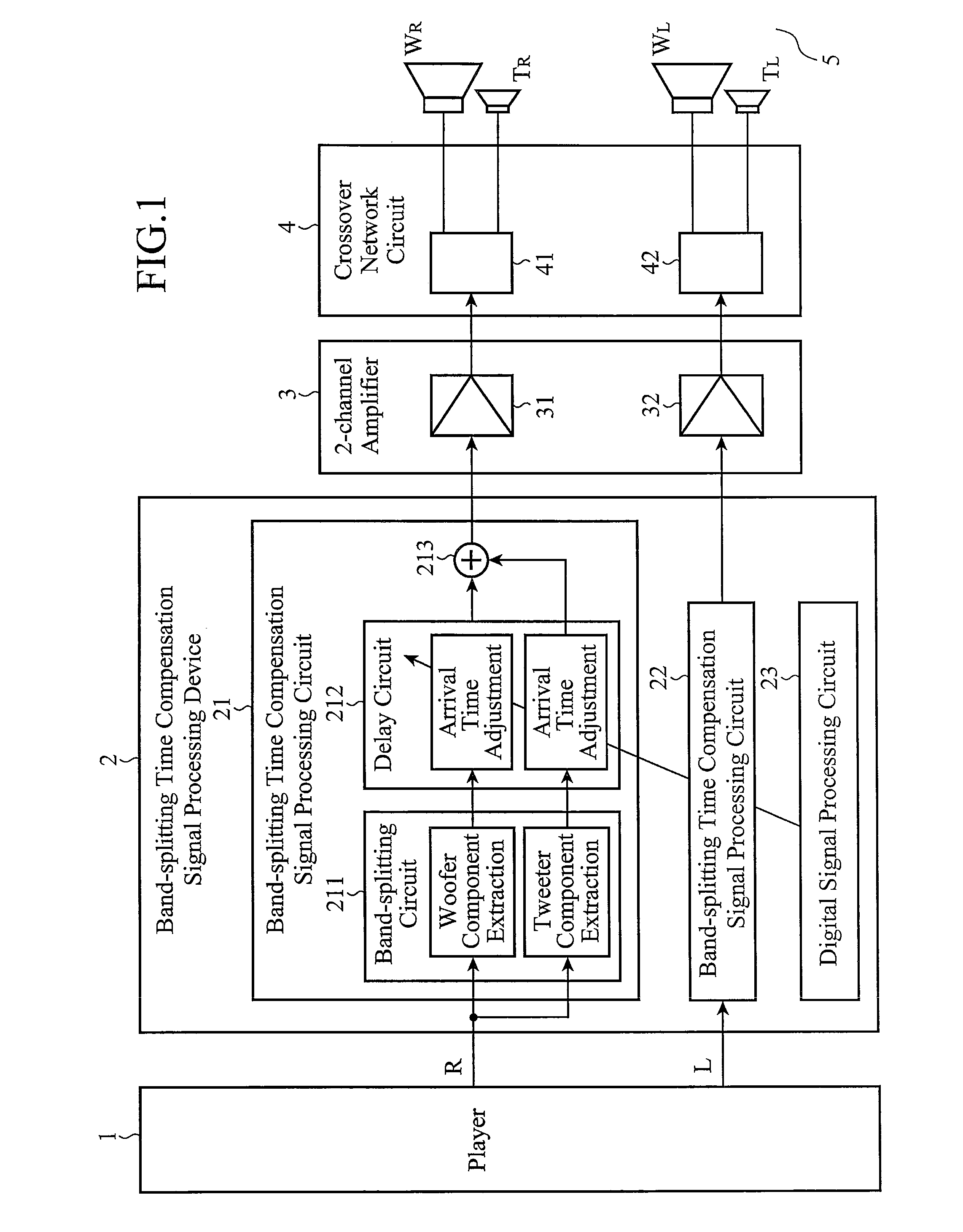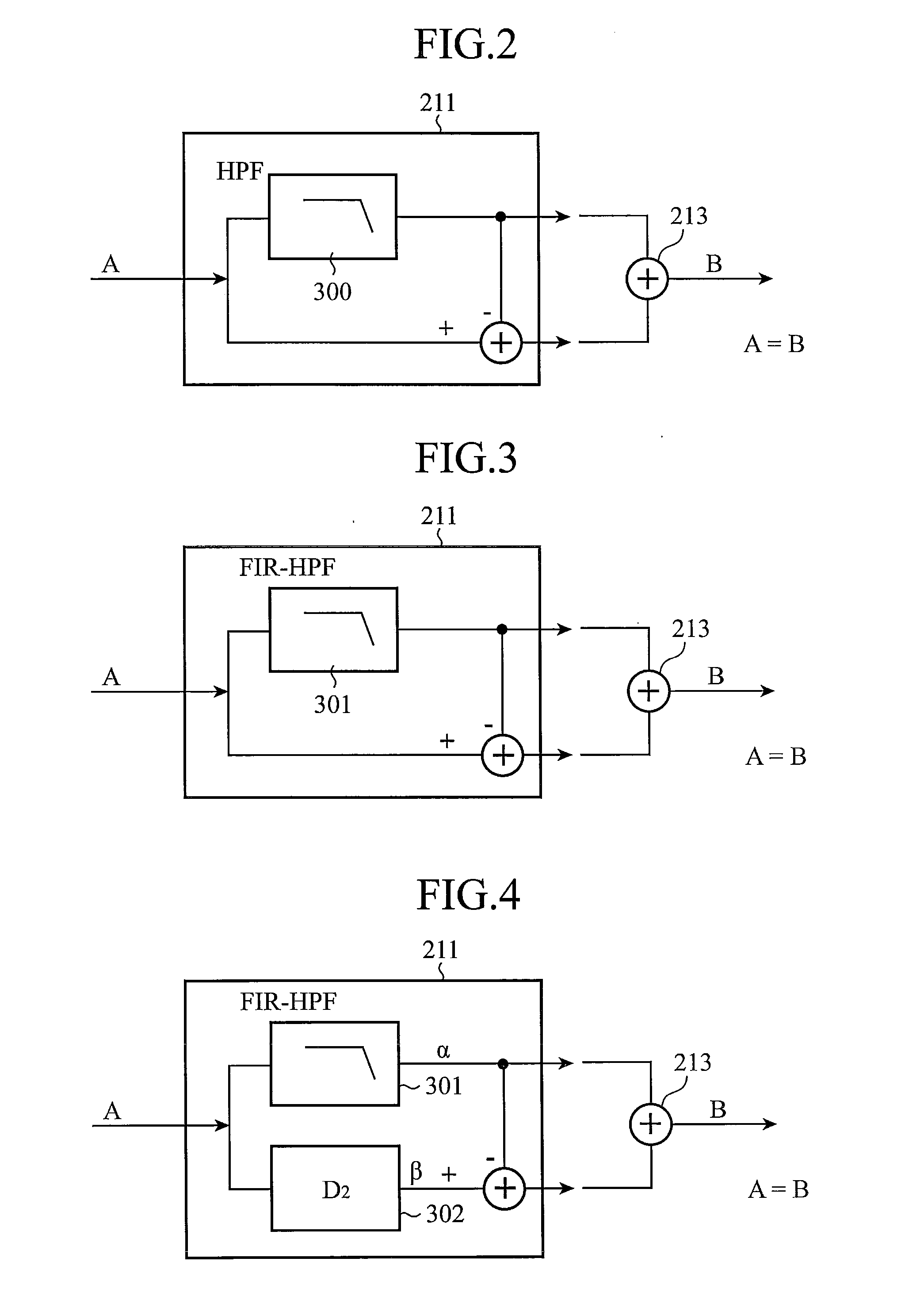Band-splitting time compensation signal processing device
a signal processing and splitter technology, applied in the direction of electrical transducers, transducer details, amplifiers, etc., can solve the problems of increasing the cost, requiring a larger space, and the inability to adjust the time axis alone without changing the other characteristics, so as to suppress the occurrence of peak, improve the linearity of transfer characteristics, and reduce the effect of peak occurren
- Summary
- Abstract
- Description
- Claims
- Application Information
AI Technical Summary
Benefits of technology
Problems solved by technology
Method used
Image
Examples
embodiment 1
[0023]FIG. 1 is a block diagram showing an internal configuration of an audio system including a band-splitting time compensation signal processing device of an embodiment 1 in accordance with the present invention.
[0024]Here, an audio system with two channels of R and L is shown as an example. The audio system includes a player 1 serving as an input source, a band-splitting time compensation signal processing device 2, a two-channel amplifier 3, a crossover network circuit 4, and two-way speaker units 5 with woofers and tweeters.
[0025]The band-splitting time compensation signal processing device 2, which has a function of correcting the bias of the sound field resulting from the distance differences between the speaker units 5 and the listening position of a listener by adjusting the arrival time of sounds, includes an R-channel band-splitting time compensation signal processing circuit 21, an L-channel band-splitting time compensation signal processing circuit 22, and a digital si...
embodiment 2
[0038]According to the band-splitting time compensation signal processing device 2 of the foregoing embodiment 1, although it can improve the linearity of the transfer characteristic at the listening position of the listener, it cannot always achieve flat frequency characteristics in the woofer component or tweeter component signal split by the difference, depending on the characteristics of the subtraction-type digital filter (subtraction-type high-pass filter 300) used for the band-splitting circuit 211 constituting the band-splitting time compensation signal processing circuit 21.
[0039]For this reason, as an example of its circuit configuration is shown in FIG. 3, the embodiment 2 which will be described below employs an FIR linear phase high-pass filter 301 consisting of an FIR digital filter as the band-splitting circuit 211 constituting the band-splitting time compensation signal processing circuit 21. Incidentally, as for the audio system to which the embodiment 2 is applied,...
embodiment 3
[0044]According to the foregoing embodiment 2, although the FIR filter with the linear phase characteristics reflects its feature in the tweeter component signal extracted by the FIR linear phase high-pass filter 301, it does not reflect its feature in the woofer component signal split by subtracting the tweeter component signal.
[0045]For this reason, as an example of its circuit configuration is shown in FIG. 4, the embodiment 3 which will be described below inserts a delay circuit 302 (second delay circuit) having a delay D2 corresponding to the group delay time of the FIR linear phase high-pass filter 301 into a path β for extracting the woofer component signal split by subtracting the tweeter component signal from the R-channel input signal in the band-splitting time compensation signal processing circuit 21.
[0046]The same is true for the L-channel input signal. Here, the term “group delay” refers to a phenomenon that outputs a toneburst with a little delay, and the term “group ...
PUM
 Login to View More
Login to View More Abstract
Description
Claims
Application Information
 Login to View More
Login to View More - R&D
- Intellectual Property
- Life Sciences
- Materials
- Tech Scout
- Unparalleled Data Quality
- Higher Quality Content
- 60% Fewer Hallucinations
Browse by: Latest US Patents, China's latest patents, Technical Efficacy Thesaurus, Application Domain, Technology Topic, Popular Technical Reports.
© 2025 PatSnap. All rights reserved.Legal|Privacy policy|Modern Slavery Act Transparency Statement|Sitemap|About US| Contact US: help@patsnap.com



